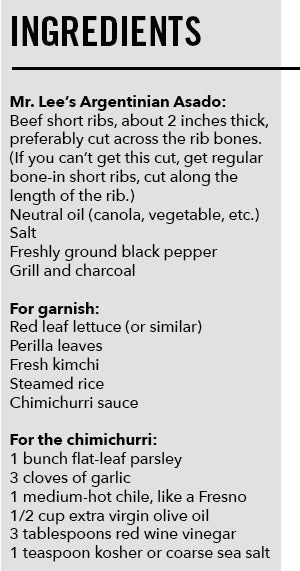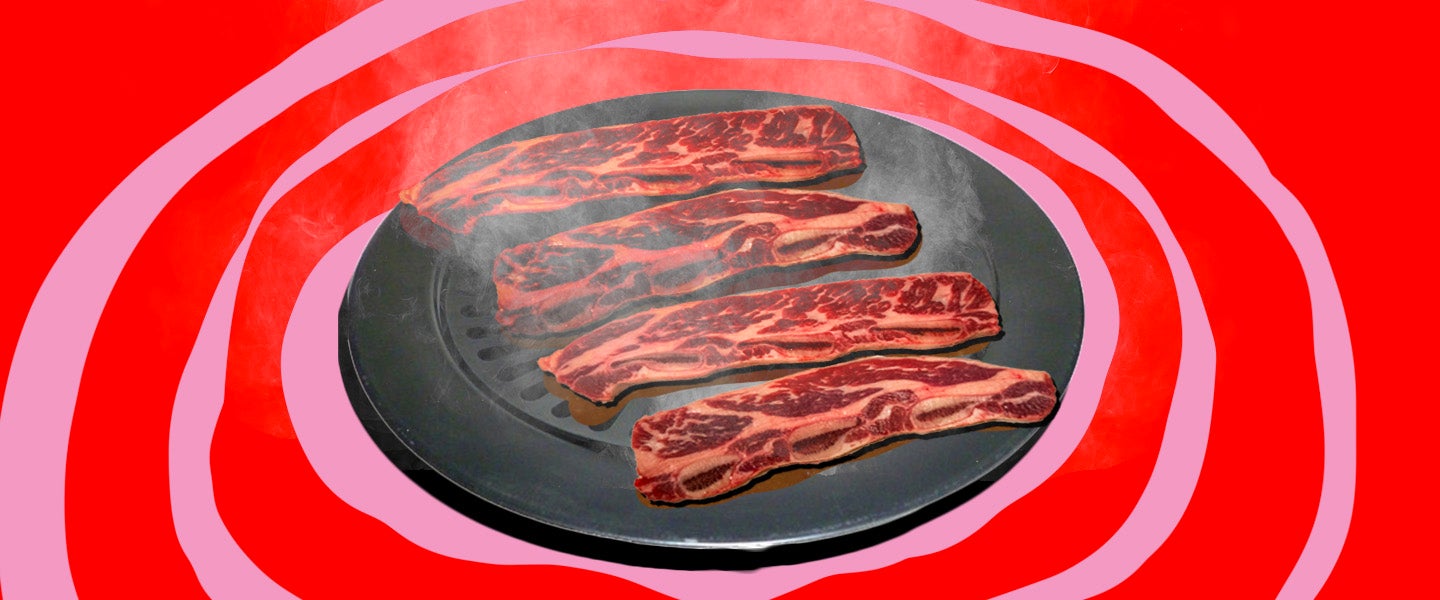Euno Lee is a content manager for amateur sports network BallerTV and a food writer based in L.A., with a deep knowledge of Korean food and L.A. culture, having grown up in the city as a first-generation Korean. He’s the fourth in a special Father’s Day series of men talking about a dish that brings as many memories of Dad as it does flavor.
My dad owned a restaurant in Koreatown that was a Korean bar — a typical watering hole, a pojangmacha, but an upscale version — with tabletop grilling and a variety of meat dishes on offer. One of his specialties was this Argentinian asado thing. He would grill a beef rib, then take it off the bone and serve it in the style of Korean bossam wraps. There would be lettuce, different kimchi and pickles to eat with slices of this big beef rib. He made it for me once, and I remember biting into it and thinking, This is not good. It’s so chewy and tough!
Me, being the asshole 21-year-old son that I was, went on Yelp and left a review for my dad’s place. By and large, it was doing pretty well, like five-star reviews from 40 people or something. So I wrote this review, but I added that people should watch out for the asado, because it’s really tough. My dad reads this shit, and he’s absolutely furious. Stuff like, “What kind of son does this to their own dad?!?!?” He was so pissed.
But this turned into a learning experience for me, because my dad sat me down and explained that Korean people, especially older Korean folks, prefer their meat to be a little chewier. It had never occurred to me that there could be generational or cultural differences at play here. The way we think about meat in America is about what cut is tender and how to keep something tender when you cook it. Especially a cut like short rib, you really don’t want to overcook it by our standards. But not by Korean standards, and that’s what my dad wanted to cater to — an old-school Korean taste.
For him to take the time to explain that to me was really valuable. It was a Korean cultural lesson, and it made me reflect on what I don’t know.
Generally speaking, food was an event for my dad. Always thinking about the next meal and good food was a way of life for him. His English wasn’t that great, so he spoke almost exclusively Korean, and my way to understand him better was to focus on communicating about food. As such, eating out at nice restaurants with him was how I grew up — whether it was going to Matsuhisa and Urasawa for top-notch sushi or Lawry’s the Prime Rib. I think he turned me into a snob, too (laughs).
He had been a chef in the Korean Navy. In Korea, you serve a mandatory two years, and for him, it was all about cooking. I think serving in the Navy instilled a notion of working hard to make something delicious and just trying to eat well when you can. He’s well-known within our extended family and among family friends as being a great cook. I still remember people randomly telling me that my dad’s kimchi was the best around. And yet, the crazy part is my dad wasn’t the cook in my household. This is pretty damning about Korean culture, but for first-gen Korean immigrants, you still see these defined gender roles in the home. My mom, even though she was a white-collar professional and had a master’s degree, was still expected to put the food together for us. Every night, it was my mom cooking. I thought it was pretty crazy, as my dad clearly could have been helping out there.
Needless to say, it was a big deal when my dad cooked. I remember one night when he made bossam. That was a big occasion for him, and he was super focused on making everything perfect. He was making the kimchi outside, seasoning the leaves of cabbage with all those spices, while also watching the pork shoulder boil. I remember having all these friends and people over just for the chance to eat his food.
But looking back, even though my connection to my dad was through food, it was a fractured experience. Back then, I only saw him every couple of months. My parents got divorced when I was 11, so these moments with him are separated by a lot of space. Still, when we were together, he’d show me how to make doenjang jiggae, Korean soybean stew. He’d show me how to break down raw squid for a stir fry.
His restaurant is closed now, so I’ll go ahead and disclose this, but he totally cooked the beef rib over an open grill fire (laughs). He basically said, “Fuck the health department.” Anything for flavor, right? So he started the beef rib on the grill, and he cooked it over hot coals until the meat hit about medium-rare inside. Then he’d stick it in a hot oven to finish cooking. He was worried it would burn on the coals. For the life of me, I couldn’t justify why he had to do that. In fact, I lost it the first time I saw it. But apparently, it was a best-seller.
Again, though, I cannot express how repugnant it seemed to 21-year-old me. He served it at the table with, I shit you not, red salsa and a chimichurri sauce. I put my head in my hands and asked why this made any sense on his menu. Korean folks, however, loved it. Talk about a cultural lesson.
* * * * *

Preheat your oven to 400 degrees. Then go outside and light up enough charcoal to get a very hot fire started in a section of your grill. Wipe down the grill grates with some oil, using a paper towel. Rub some of the oil on the short rib, too, then sprinkle generously with salt. When the fire is hot — you shouldn’t be able to hold your hand over the grill surface for more than a few seconds — throw on the short ribs.
Cook them, turning every minute or so, until every surface is seared and the meat is about medium-rare (use an instant-read thermometer to pull it at 130 degrees). Finish cooking the meat in the oven, to about medium-well (155 degrees). Let it rest for 5 minutes, then slice and arrange on a platter with the garnishes.
For the chimichurri, take about half of the parsley bunch, trim off the bare stems and chop into a fine mince. Place into a bowl. Slice the garlic thinly, then continue to mince. Sprinkle the coarse salt on the garlic, and use the side of the knife to mash and grind the mince with the salt. Place this loose paste into the bowl.
Halve the chile and take out the seeds if you want to reduce the spice level. Chop the chile into a fine mince. Combine it in the bowl with the rest of the ingredients, and stir well to combine. Let the chimichurri sit for at least half an hour before serving, so the flavors mellow and mix.

